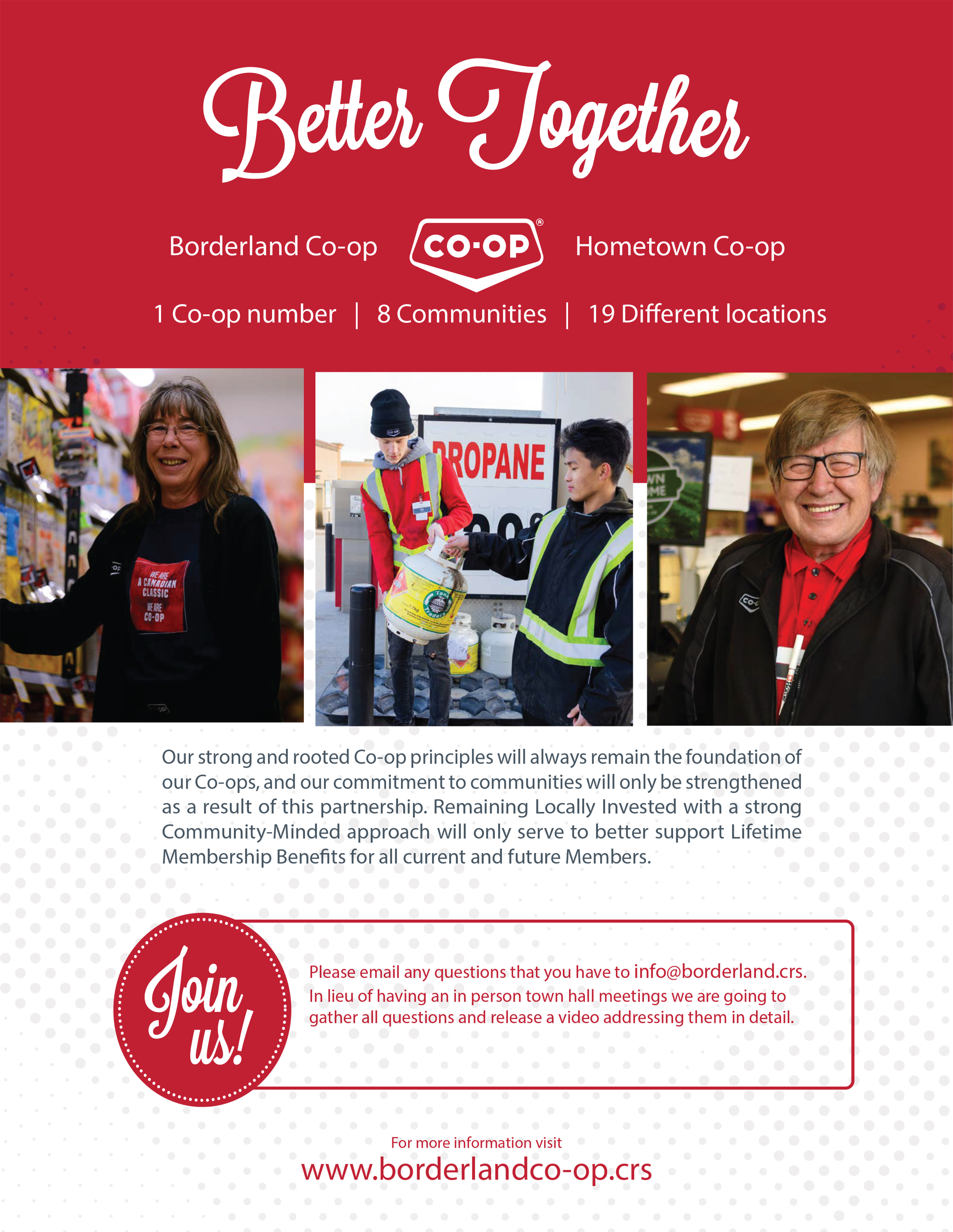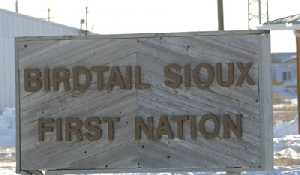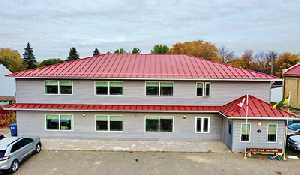Management agreement led to merger proposal
April 27, 2021, 9:05 am


Borderland Co-op and Hometown Co-op have announced a proposal to merge—a merger that, if it is accepted by members of both Co-ops, will create a Co-operative with 19 locations in eight communities, with annual sales of $110 million. Kevin Weedmark spoke with Borderland CEO and Hometown GM Jason Schenn about the proposal. Following is a full transcript of the interview.
Remind me how Borderland and Hometown came to work together initially.
Hometown a few years ago had let go of their General Manager and they hired an interim manager to come in and kind of help get them back on their feet, and that fellow was a retired General Manager from elsewhere in the system who came in and did all the top stuff that had to be done. And when he was getting to the end of his contract they were deciding whether or not they were going to look for their own General Manager or seek a management agreement with another retail.
They reached out to us and asked if we’d be interested in submitting a proposal, and we did, and they decided to come on board with us for the management agreement side. We’re providing accounting services, HR services and leadership services from myself and my office crew. Over the course of the past year the relationship has gone well and the boards started talking that there would be some efficiencies of us being together, and that led to doing a bunch of feasibility studies and then looking into how this could work and having a bunch of discussions over policy and bylaws and alignment and that kind of thing. Everybody managed to come to an agreement fairly easily and resulted in us wanting to take it to the membership for their approval. That’s in a nutshell how it all went.
So now the members of both Co-ops have to approve a merger? Is it a straight majority vote in favor of the amalgamation and then it goes forward?
We need the support of two thirds of those present at our annual meetings. Each Co-op will have their own annual meeting and we’ll have our own annual meeting and the resolution that we’re bringing forward will appear at those meetings for discussion and vote. If both retails vote with a two-thirds majority or better to go forward with it, then it goes forward. If one of them doesn’t, then it doesn’t.
What do you see as the benefits of merging and forming one larger Co-op?
Strength in numbers, really. You can see what’s happening across rural communities.
It’s hard to keep stand-alone operations running when you don’t have a whole lot of resources or good balance sheet.
When you can harness the power of bringing two organizations together, lots of locations, it makes it easier to find economies of scale.
You bring more purchasing power to the table, you can use your inventory better, there’s just tons of areas where money can be used smarter.
It’s also about making sure that you can widen out areas of service.
Borderland has a fairly strong balance sheet and we’ve been that way for a long, long time now. Being able to share what we have across more rural communities makes it stronger for all the rural communities.
We can share inventory across more locations, we can be more strategic in how we have our product laid out and get it to more places quicker.
That’s why we’re putting trucks on the road and trying to maximize what we can do within our own neighborhood because we can’t always count on suppliers to have inventory in their warehouses and get it out to us quickly.
Assuming your members approved the merger, what kind of work is involved in switching things over? Is there much work behind the scenes on the accounting side?
Oh there is. You’re taking two entities and you’re turning them into one. So every supplier, every creditor, everyone out there you have to alert them and there’s a thousand lines of paperwork that have to be completed in order to make sure it all goes through and gets done right so that we can maintain relationships.
There’s a ton of details. Really, it’s all behind the scenes stuff that goes into making two sets of books one set of books and bringing the governance package together. We’ve got a lot of tough parts done with bylaws and governance. We’ve agreed to all those points already, so taking that forward to the membership it’s ‘here’s what you’re voting on.’ There’s no ambiguity and this is the package, and it’s pretty open and clear.
Do you see any downsides to it? For example, once you get to a certain size, is it hard to keep that local Co-op feeling?
You know, you’re right. There are some challenges in that, the bigger an organization gets. It’s one of my things I will mention often around here, when you start talking about eight communities that we’re going to be in and 320-plus employees, it gets to a point where I won’t have the opportunity to meet or talk to everyone of our employees during their time potentially. That’s hard, just because I’ve been used to being so deeply involved over the years.
But on the same note it also gives us the opportunity to increase the leadership quality of what we have and I think that makes a big difference. Obviously we wouldn’t have gotten bigger if people didn’t support the organization and found that it was beneficial to them to do so. Through that process we’ve added leaders.
When I first started here 15 years ago, our admin department was three people, there was myself and two others in the admin office and we handled everything that we possibly could.
Fast forward 15 years, we’ve got 17 people in our admin department alone now, and professionals in accounting, HR. We’ve added professional-level people to our communities. So that has a benefit to the community in a bigger sense, but it means I have to relinquish some of that control and the ability to see what’s going on everywhere all the time and that’s hard for me because I like being involved and seeing what’s going on everywhere, but I also trust the group that I have. They’re a good group of people and they do a good job of working with the staff, and the management over at Hometown wouldn’t be interested in this if we weren’t able to serve them well along the way as well.
Are there some efficiencies you can gain by running the two together?
Mostly economies of scale. Basically, merging two volumes. Hometown is about $38 million in volume, Borderland is about $70 million in volume. You put those together, you’re at $110 million and then there’s some ability for Borderland to serve Hometown’s traditional territory with more of the home centre stuff and there’s a potential on their side to serve more farmers in our area and the ag side.
It’s things like that, the growth potential is what it’s more about. We talk about $100,000 a year in efficiencies. In a $110 million organization, it’s not huge dollars that end up being saved.
Most of the benefit is the ability to grow and support communities, make them stronger and maybe figure out a way to keep rural communities a little more viable in the long term. That’s one thing I really think is important.
It’s really hit home over the course of the pandemic. We operate, generally, the only food store in our communities and the shop local component that everyone’s been talking about here has been valid for 100 years, but because of the pandemic it’s more top of mind for everybody.
What we saw in this last year, is when people support their local stores, they are profitable, they can be profitable, they can last a long time if people support them.
It’s renewed, my feeling on the future of small town retail. Before I was getting frustrated, a lot of people are getting frustrated in small town business because the pull of the cities, but I think this renewed our faith in that there is potential there that if the community supports it these things can last a long, long time.
That’s our renewed focus—by being together, by having more expertise and having the ability to try and figure out how we can run these businesses, especially small town food stores and hardware stores, to be more efficient and drive some unnecessary cost out of the equation that we can keep those jobs, keep those facilities in our communities in the long term.
If you combine and have $110 million in annual sales, would the combined Co-op be one of the larger ones in rural Saskatchewan? Or are a lot of Co-ops merging and becoming bigger entities now?
Actually, as a rural Co-operative—totally rural based—we actually end up being more similar to your urban centres in terms of volume.
That’s a big part of our mission here, too. We want to be a voice in our system for the rural Co-ops. No knock on any of our sister Co-ops that are out there, a lot of them have an urban centre, a large urban centre that they operate out of and that’s always going to be a priority.
We very much need our urban centres in the co-operative system to be able to perform well because it’s a volume based business where everything we do is based on volume and they drive a lot of volume which is important.
But when we get to the table, we need to be a voice for the rural Co-ops in those smaller communities that are out there and that’s where I feel like I can fill a void and be a voice for rural Co-operatives at the table.
I’ve been involved in lots of advisory committees, executive councils and things like that to be that voice. When you have more volume, you have more clout to make sure your voice is heard and I think that’s important for our rural communities.
But yes, when you talk about the size, in our general neighborhood when you start thinking about the other larger Co-ops in the area, Advantage or Twin Valley or Valleyview or Yorkton, this would be bigger than all of those individually.
With that scale does it help with building and upgrading your facilities?
Well, you know, everything’s got to be the right size for the community you’re serving. The cost for construction these days, holy man, but we’ve got a project list a mile long of what we want to do and a lot of it comes down to what’s going to give us the best return on investment.
Assuming the merger is approved, once you’ve combined, do you basically look at the whole project list for both Co-ops and prioritize capital projects?
To be honest with you, I’ve been working with Hometown for a year now and I’ve always had it in the back of my mind because often times these management agreements do evolve—sometimes they do, sometimes they don’t—but that was something I was cognizant of while building their development plans is that when you have these development plans for both retails, that they have to dovetail in terms of timelines, resources and things like that.
So it’s been the thing in my head that’s been an underlying recognition that the priorities have to line up and have to dovetail.
There are some projects that are traditionally Borderland and some that are Hometown that’ll all get done in their priority sequence.
It’s not necessarily this community’s first, this community’s second or anything like that—it’s based on the merits of the projects.

 Tweet
Tweet



































